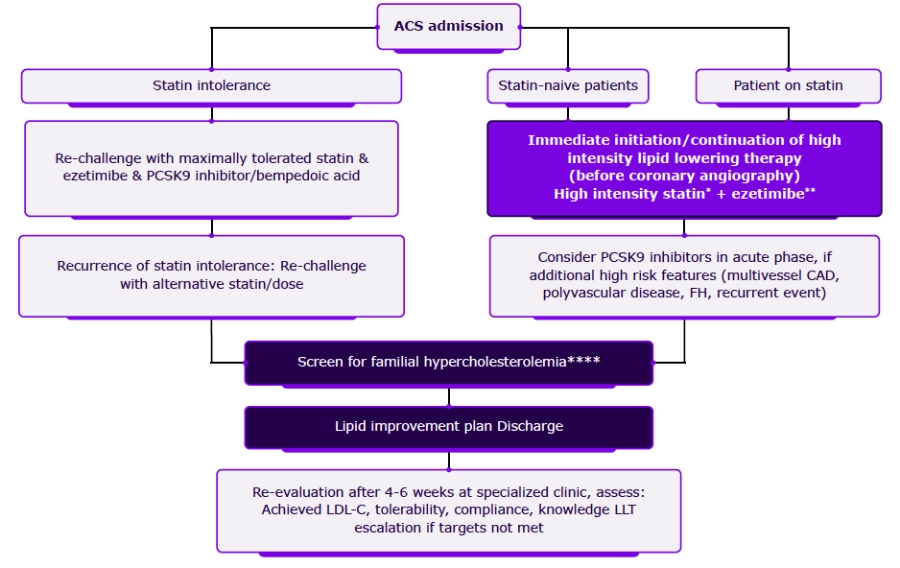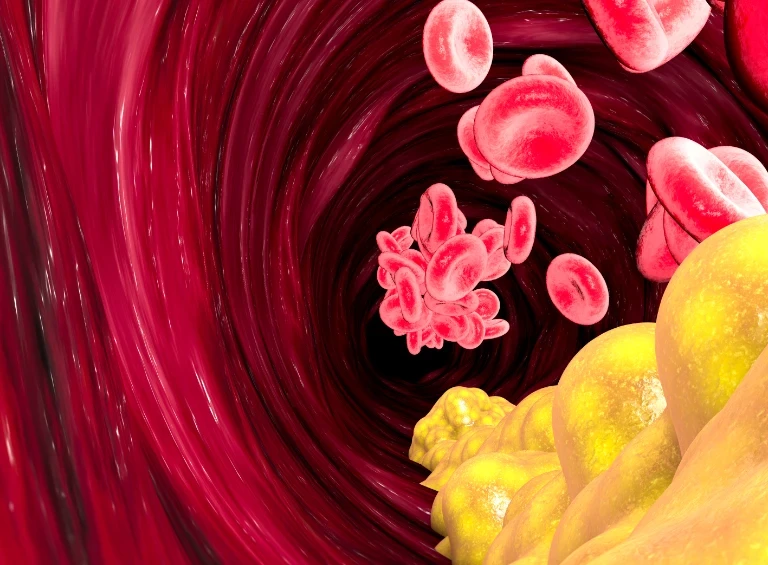Acute LDL-C Reduction Post ACS: Strike Early and Strike Strong: From Evidence to Clinical Practice
A clinical consensus statement of Association for acute cardiovascular care (ACVC), in collaboration with European association of preventive cardiology (EAPC) and the European Society of Cardiology working group on cardiovascular Pharmacotherapy
Krychtiuk KA, et al. Eur Heart J Acute Cardiovasc Care. 2022;11(12):939–949.
Key Takeaway
Patients experiencing ACS are at high risk for recurrent ischemic CV events, in very early phase (within 1–3 months after index event)
Reduction in ASCVD risk is known to be proportional to absolute LDL-C reductions post-ACS ("the lower, the better approach")
The ESC/EAS guidelines recommend a stepwise initiation and escalation of LLT, with re-evaluation of LDL-C goals after 4–6 weeks
Observational data showed, low rates of guidelinerecommended LLT adaptions and LDL-C target goal achievement, which leaves patients at residual risk (vulnerable post-ACS phase)
Even with LDL-C assessments and therapy escalations every 4–6 weeks:
Achieving target goals might take up to 3 months, coinciding with the highest risk period for recurrent CV events
In addition to the well-established ‘the lower, the better’ principle, ‘strike early and strike strong approach’, upfront initiation of a ‘combined lipid-lowering approach using high-intensity statins and ezetimibe’ seems reasonable in the early post-ACS phase
- Therefore, a lipid-lowering strategy of ‘strike early and strike strong’ to be discussed in all patients with ACS, with immediate initiation of statin therapy and a dual lipid-lowering strategy as a default strategy
Acute PCSK9 inhibition is a novel strategy that needs to be considered, in patients with high-risk features*
Why This Matters
Despite current guidelines suggesting a stepwise lipidlowering approach, data suggest that after ACS:
- Few lipid-lowering drugs are prescribed and few dose adjustments are performed following hospital discharge
- Majority of patients do not achieve their goals
Even in ideal post-ACS scenario, it can take up to 12 weeks† for patients to receive optimal LLT when following the stepwise approach
‘Strike early and strong’ strategy using an optimal combination of effective and safe lipid-lowering agents may represent a therapeutic tool in these patients
Proposed Lipid-lowering Algorithm Post-ACS
Upfront initiation of a combined lipid-lowering approach using high-intensity statins and ezetimibe

*High intensity statin treatment defined as atorvastatin (40-) 80 mg; rosuvastatin 20 (-40) mg
**In patients with untreated LDL-C<70 mg/dL, high intensity statin treatment only may be considered
***Lipoprotien(a) levels should be measured if unknown as part of overall risk estimation
****Particularly in pateints with very high (untreated) LDL-C (>190 mg/dL) or high (untreated) LDL-C (>160 mg/dL) in the presence of premature AMI or a family history of premature AMI
Please refer the source publication Krychtiuk KA, et al. for additional details
*Multivessel CAD, polyvascular disease or FH
†The most vulnerable phase after a major coronary event
ACS, acute coronary syndrome; AMI, acute myocardial infarction; ASCVD, atherosclerotic cardiovascular disease; CAD, coronary artery disease; CV, cardiovascular; EAS, European Atherosclerosis Society; ESC, European Society of Cardiology; FH, familial hypercholesterolemia; LDL-C, low density lipoprotein-cholesterol; LLT, lipid-lowering therapy; PCI, percutaneous coronary intervention; PCSK9, proprotein convertase subtilisin/kexin type 9; RCTs, randomized clinical trials.
- Krychtiuk KA, Ahrens I, Drexel H, Halvorsen S, Hassager C, Huber K, et al. Acute LDL-C reduction post ACS: strike early and strike strong: from evidence to clinical practice. A clinical consensus statement of the Association for Acute CardioVascular Care (ACVC), in collaboration with the European Association of Preventive Cardiology (EAPC) and the European Society of Cardiology Working Group on Cardiovascular Pharmacotherapy. Eur Heart J Acute Cardiovasc Care. 2022;11(12):939–949. doi: 10.1093/ehjacc/zuac123. PMID: 36574353

